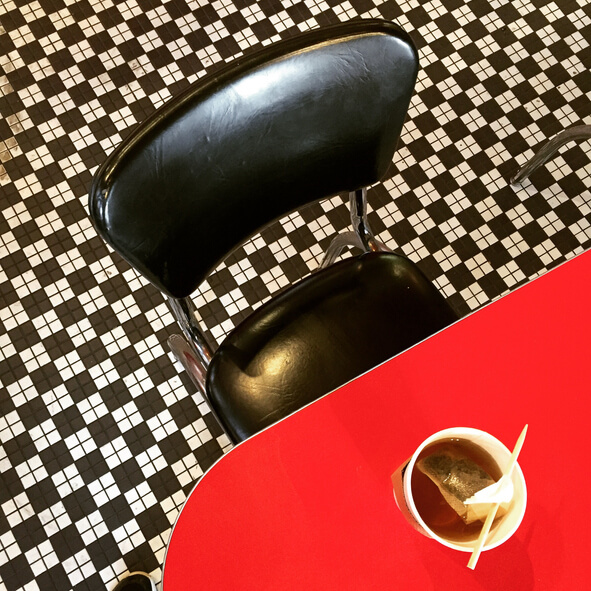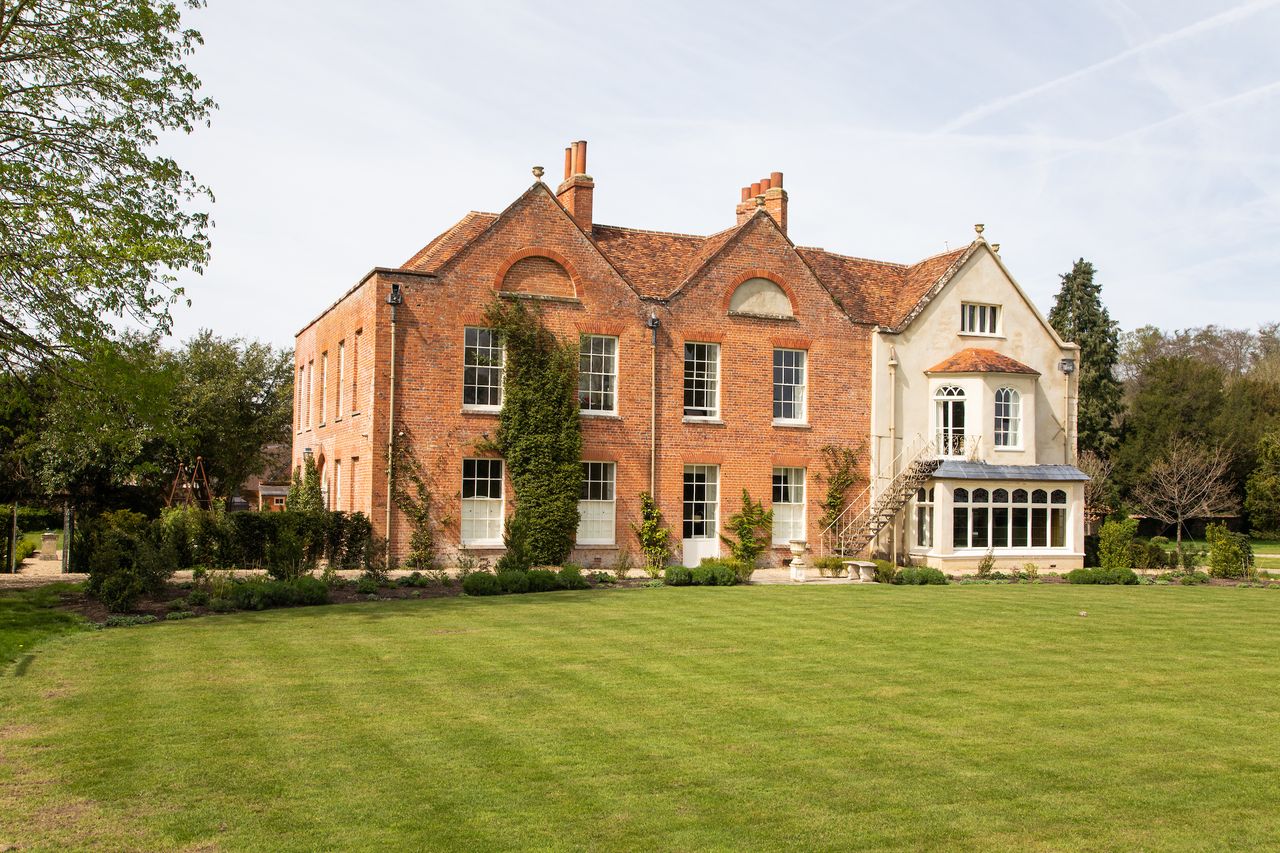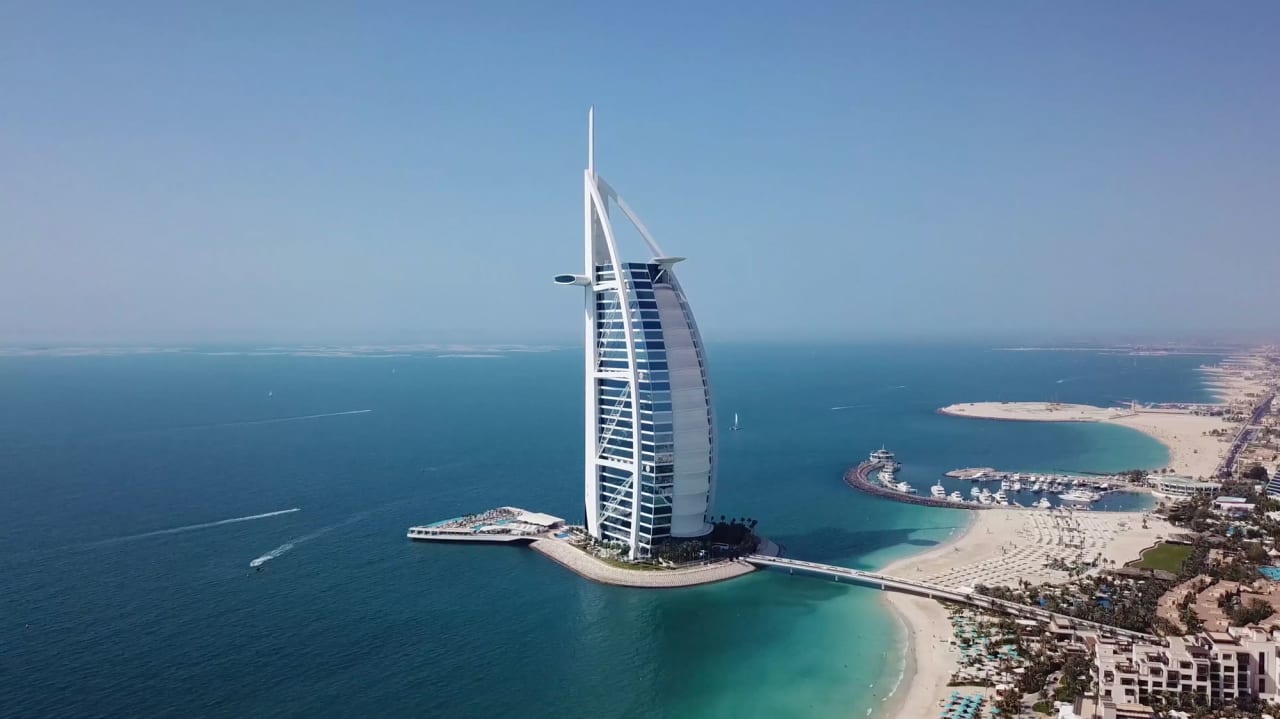When Did Linoleum Get So Luxe?
Seduced by its versatility and velvety good looks, designers are putting the old-school staple to surprising use in cabinetry, flooring and furnishings—proving it’s not only sustainable but chic.
FOR DECADES linoleum has been shorthand for downmarket and drab, the stuff of dingy, unrenovated kitchens and hospital corridors. But lately that bad rap is fading, thanks to creative, environmentally conscious designers who are approaching the material with fresh eyes. In the linoleum renaissance, the colours are rich and sophisticated, the patterns unexpected. In cabinetry and furnishings as well as underfoot, these new, elevated versions argue persuasively that the utilitarian workhorse can deliver practicality with panache.
Patented in the 1860s by English inventor Frederick Walton, “linoleum was actually quite fashionable and cutting edge when it was created,” explained Alexandra Lange, a design critic and author of five books on 20th century design including “Meet Me by the Fountain: An Inside History of the Mall.” That popularity, she added, endured for over a century. By the 1920s, companies like Armstrong Flooring (which no longer produces linoleum, but was a major player throughout the 20th century) offered hundreds of designs, a tempting menu of textures, hues and patterns that ranged from simple marble swirls to Persian “carpets.” But by the 1990s, attitudes—at least in America—shifted, leaving lino in limbo. “Around 2000, you started to see a fetishisation of luxury and ‘natural’ materials like stone and wood,” said Ms. Lange.
Despite its cut-rate reputation—and the way it is unfairly lumped together with plastic products like laminate counters and vinyl flooring—linoleum remains one of the “greenest” materials on the interiors market. Made from organic components like cork dust, linseed oil, and jute, it can be easily renewable and recyclable. Also, said Ms. Lange, lino is light and inherently soft—as low-impact on the body as it is on the planet.
Daniel Rabin and Annie Ritz of And And And Studio, a Los Angeles design firm, say environmental motives were among the reasons they began experimenting with linoleum as a cabinet veneer in 2018. “Because of the rules around VOCs, painting cabinets is almost a non-option in California these days—the paints that are truly hard-wearing just can’t be used,” explained Mr. Rabin. “[Coloured] lino performs almost the same way, while also hiding fingerprints and being super durable.”
At a midcentury home in Los Angeles’s Silver Lake neighbourhood the duo chose furniture-grade linoleum by Forbo—the Switzerland-based brand preferred by all the designers we spoke with—to clad both the kitchen cabinets and the walls running along a curving butler’s pantry and powder room. While many other so-called “modern” finishes lean hard and cold, “the haptic quality, the touch of [linoleum], is warm and soft and matte,” said Mr. Rabin. “It has this beautiful way of interacting with light and sound.”
In London, Malcolm Weir and Tom Jarvis of the kitchen workshop West & Reid have taken to using linoleum on everything from custom cabinetry to their own office desks. “As soon as clients touch it, they get it—especially if it’s a colour they like,” Mr. Jarvis said. As with luxury paint company Farrow & Ball, Forbo’s furniture linoleum comes in limited hues, but the narrow selection—including a pale pink and moody pistachio—tends to be sophisticated and cannily on-trend.
Reform, a kitchen design firm in Copenhagen, collaborates with international architects on a range of cabinets, drawers, and panels that pay homage to the traditions of Nordic modernism. In 2014, its first line, BASIS, included a lino option; eight years later, those linoleum cabinets remain the company’s best seller, said CEO and founder Jeppe Christensen. “It was not so big a leap for us because so many of the innovative midcentury Scandinavian makers who inspire us, like Arne Jacobsen, were creating wonderful things with linoleum in the ’50s and ’60s.”
Beata Heuman, the Swedish-born, London-based interior designer known for crafting playful, cosmopolitan interiors, also credits her affection for linoleum to her childhood in Scandinavia where, she said, it never really fell out of fashion. “There’s something really subtle and lovely about it—it’s a big part of my repertoire,” said Ms. Heuman.
In a hotel project currently underway in Paris, Ms. Heuman has run linoleum along the walls of a powder room in the manner of a dado panel. For past residential assignments, she has used lightly marbled sheets of linoleum flooring everywhere from tidy living rooms to family bathrooms. The material, she said, has a wonderful way of warming up the space and “bring[ing] luxe finishes back down to earth.”
In kitchens, lino squares remain classic. “Checkerboard can feel a little cliche, but we recently put pale cream and gray together and that felt really peaceful and serene,” Ms. Heuman explained, noting that the sometimes aggressive pattern assumes a gentler personality when executed in neutrals. For the mudroom of a family home in Notting Hill, the designer updated a mosaic linoleum she spied in a photo of an Art Deco-era New York City vestibule. “There are so many possibilities,” she said with a laugh. “Honestly, my total fantasy would be to partner with Forbo and design a range of linoleum for them.”
Linoleum is “really good at crossing the high-low line,” said Rustam Mehta of the New York firm GRT Architects. Indeed, for a current project—an ambitious, top-dollar reimagining of a Harlem townhouse—Mr. Mehta uses the material not just as a luxe, powder-pink drawer facing in the kitchen and dining rooms but also, in hunter green and deep red, to top two custom-millwork desks. “It evokes a classic leather writing surface,” he explained.
“We’re at this interesting place,” said Mr. Mehta. “It’s like subway tile or penny tile—people love to elevate these simple things. Americans know what linoleum is but might not know what it can be.”
 Copyright 2020, Dow Jones & Company, Inc. All Rights Reserved Worldwide. LEARN MORE
Copyright 2020, Dow Jones & Company, Inc. All Rights Reserved Worldwide. LEARN MORE
This stylish family home combines a classic palette and finishes with a flexible floorplan
Just 55 minutes from Sydney, make this your creative getaway located in the majestic Hawkesbury region.
As Paris makes its final preparations for the Olympic games, its residents are busy with their own—packing their suitcases, confirming their reservations, and getting out of town.
Worried about the hordes of crowds and overall chaos the Olympics could bring, Parisians are fleeing the city in droves and inundating resort cities around the country. Hotels and holiday rentals in some of France’s most popular vacation destinations—from the French Riviera in the south to the beaches of Normandy in the north—say they are expecting massive crowds this year in advance of the Olympics. The games will run from July 26-Aug. 1.
“It’s already a major holiday season for us, and beyond that, we have the Olympics,” says Stéphane Personeni, general manager of the Lily of the Valley hotel in Saint Tropez. “People began booking early this year.”
Personeni’s hotel typically has no issues filling its rooms each summer—by May of each year, the luxury hotel typically finds itself completely booked out for the months of July and August. But this year, the 53-room hotel began filling up for summer reservations in February.
“We told our regular guests that everything—hotels, apartments, villas—are going to be hard to find this summer,” Personeni says. His neighbours around Saint Tropez say they’re similarly booked up.
As of March, the online marketplace Gens de Confiance (“Trusted People”), saw a 50% increase in reservations from Parisians seeking vacation rentals outside the capital during the Olympics.
Already, August is a popular vacation time for the French. With a minimum of five weeks of vacation mandated by law, many decide to take the entire month off, renting out villas in beachside destinations for longer periods.
But beyond the typical August travel, the Olympics are having a real impact, says Bertille Marchal, a spokesperson for Gens de Confiance.
“We’ve seen nearly three times more reservations for the dates of the Olympics than the following two weeks,” Marchal says. “The increase is definitely linked to the Olympic Games.”

Getty Images
According to the site, the most sought-out vacation destinations are Morbihan and Loire-Atlantique, a seaside region in the northwest; le Var, a coastal area within the southeast of France along the Côte d’Azur; and the island of Corsica in the Mediterranean.
Meanwhile, the Olympics haven’t necessarily been a boon to foreign tourism in the country. Many tourists who might have otherwise come to France are avoiding it this year in favour of other European capitals. In Paris, demand for stays at high-end hotels has collapsed, with bookings down 50% in July compared to last year, according to UMIH Prestige, which represents hotels charging at least €800 ($865) a night for rooms.
Earlier this year, high-end restaurants and concierges said the Olympics might even be an opportunity to score a hard-get-seat at the city’s fine dining.
In the Occitanie region in southwest France, the overall number of reservations this summer hasn’t changed much from last year, says Vincent Gare, president of the regional tourism committee there.
“But looking further at the numbers, we do see an increase in the clientele coming from the Paris region,” Gare told Le Figaro, noting that the increase in reservations has fallen directly on the dates of the Olympic games.
Michel Barré, a retiree living in Paris’s Le Marais neighbourhood, is one of those opting for the beach rather than the opening ceremony. In January, he booked a stay in Normandy for two weeks.
“Even though it’s a major European capital, Paris is still a small city—it’s a massive effort to host all of these events,” Barré says. “The Olympics are going to be a mess.”
More than anything, he just wants some calm after an event-filled summer in Paris, which just before the Olympics experienced the drama of a snap election called by Macron.
“It’s been a hectic summer here,” he says.

AFP via Getty Images
Parisians—Barré included—feel that the city, by over-catering to its tourists, is driving out many residents.
Parts of the Seine—usually one of the most popular summertime hangout spots —have been closed off for weeks as the city installs bleachers and Olympics signage. In certain neighbourhoods, residents will need to scan a QR code with police to access their own apartments. And from the Olympics to Sept. 8, Paris is nearly doubling the price of transit tickets from €2.15 to €4 per ride.
The city’s clear willingness to capitalise on its tourists has motivated some residents to do the same. In March, the number of active Airbnb listings in Paris reached an all-time high as hosts rushed to list their apartments. Listings grew 40% from the same time last year, according to the company.
With their regular clients taking off, Parisian restaurants and merchants are complaining that business is down.
“Are there any Parisians left in Paris?” Alaine Fontaine, president of the restaurant industry association, told the radio station Franceinfo on Sunday. “For the last three weeks, there haven’t been any here.”
Still, for all the talk of those leaving, there are plenty who have decided to stick around.
Jay Swanson, an American expat and YouTuber, can’t imagine leaving during the Olympics—he secured his tickets to see ping pong and volleyball last year. He’s also less concerned about the crowds and road closures than others, having just put together a series of videos explaining how to navigate Paris during the games.
“It’s been 100 years since the Games came to Paris; when else will we get a chance to host the world like this?” Swanson says. “So many Parisians are leaving and tourism is down, so not only will it be quiet but the only people left will be here for a party.”
This stylish family home combines a classic palette and finishes with a flexible floorplan
Just 55 minutes from Sydney, make this your creative getaway located in the majestic Hawkesbury region.






















